Are you planning a trip to Thailand and looking to discover its stunning wildlife? Well, hold on tight because I’ve got some jaw-dropping information about the most dangerous animals in Thailand you need to be aware of.
Thailand is home to many enchanting creatures, and the vast majority of animals you encounter will be friendly and no harm to humans, but there are some animals that live in Thailand that could pose a threat.
While we don’t want to scare you, it’s important to know what animals you may face, even if it’s a slim chance, just so you know to stay vigilant.
If you’re wondering what are the most dangerous animals in Thailand you need to be aware of, here are the most deadly…
Fair warning: some of the photos in this guide may make your spine shiver! They did for us!
The Most Dangerous Animals in Thailand
We’ve organized this list in order of what we think are the most dangerous to the least dangerous animals. Fortunately, sightings of these dangerous animals are rare, but remember to stay vigilant.
1. Box Jellyfish

The Venomous Vipers of the Sea, who creep silently in the shallow waters surrounding the islands. Imagine encountering the most venomous creature on Earth during your beach getaway.
Yes, I’m talking about the infamous Box Jellyfish. With nearly transparent bodies, these gelatinous creatures can deliver a sting that is not only excruciatingly painful but also potentially life-threatening.
According to reports, there have been 8 deaths from Box Jellyfish stings in Thailand since records began in the 1990s.
Though most beaches where sightings are known have jellyfish nets, many of the islands do not, so you need to stay vigilant when swimming in Thailand’s beautiful waters.
- Where in Thailand can you find it: Box Jellyfish tend to live in the Andaman Sea and can be found swimming in the waters off of Phuket, The Phi Phi Islands, Krabi, and Koh Lanta. They can be found swimming in the Gulf of Thailand off the coasts of Koh Samui and Koh Phangan. Koh Phangan has seen the highest number of jellyfish attacks than any other destination in Thailand.
- When are they most active? Usually, Box Jellyfish are more active at night as the moonlight attracts them to the surface, however they prefer to swim in shallow shores and calm waters, which is why they are more dangerous at beaches in Koh Phangan where the waters are shallow.
- What to do if you encounter one: Because Box Jellyfish are transluscent and move slowly, they can be hard to spot. If you do encounter one, swim away as quickly as possible.
- What happens if they sting you? If you are stung on the arm or leg, you will most likely be in severe pain for hours and have deep welts that take months to heel. If the tentacles wrap around the torso, then the common result is a quick death. If you do get stung by a Box Jellyfish, the advice is to pour vinegar over the stings as soon as possible and seek medical attention.
2. Indo-Chinese Spitting Cobra
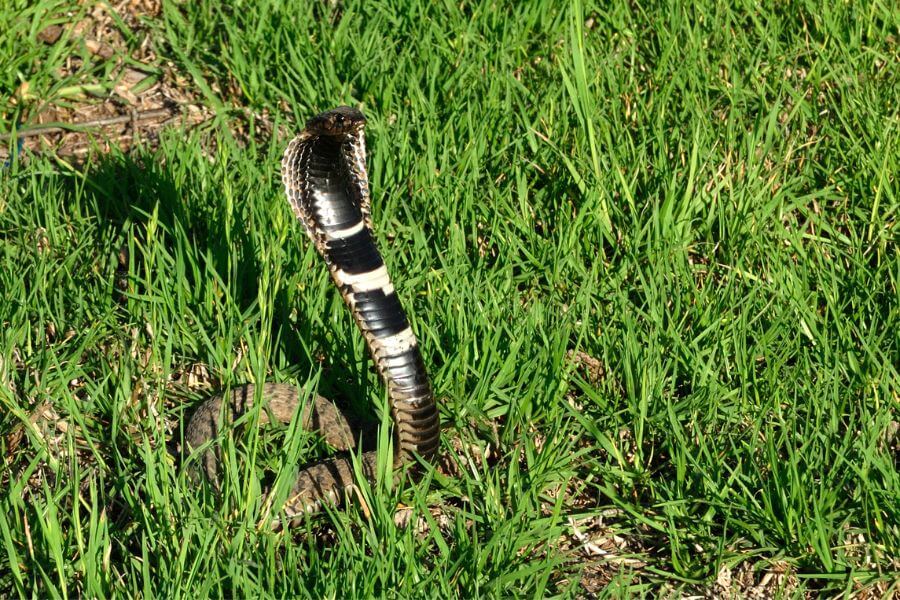
If there’s one jungle creature you don’t want to come face-to-face with, it’s the cunning Spitting Cobra, known locally as either the Indo-Chinese Spitting Cobra, Thai Spitting Cobra, or Siamese Spitting Cobra.
Known for its ability to spray venom accurately up to three meters away, this snake in Thailand is not one to mess with.
They are characterized by their white tummys, though their backs may be brown or gray in color. They can grow up to 1.2 meters in length and can be found all over the country.
If you find yourself strolling through the wilderness at night, make sure to stay alert and keep your distance from these slithering danger noodles.
- Where in Thailand can you find it: Spitting Cobras like to hang around rural areas, including in jungles, lowlands, hills, forests and plains. They are occasionally attracted to human areas when there is a large population of rodents for them to eat.
- When are they most active? Thankfully for us humans, the Spitting Cobra is a nocturnal creature and is most active at night, so unless you’re doing a jungle walk at night, you’re unlikely to encounter one. In the daytime, they are usually timid creatures and burrow under branches and leaves.
- What to do if you encounter one: Leave it alone! Do not approach the snake and back away slowly, trying your best not to spook it. If any of its venom lands on your skin, wash it off right away and ensure you don’t get any of it inside any cuts or openings in the skin.
- What happens if they bite you? The bite of a Spitting Cobra can be potentially lethal to humans. Most of the time, a bite victim will experience pain, swelling and decay of the skin around the wound. The venom can also cause paralysis and, by consequence, asphyxiation, if treatment isn’t administered quickly. If venom reaches the eyes, it can cause permanent blindness.
Read more: Are there crocodiles in Thailand?
3. Giant Centipede
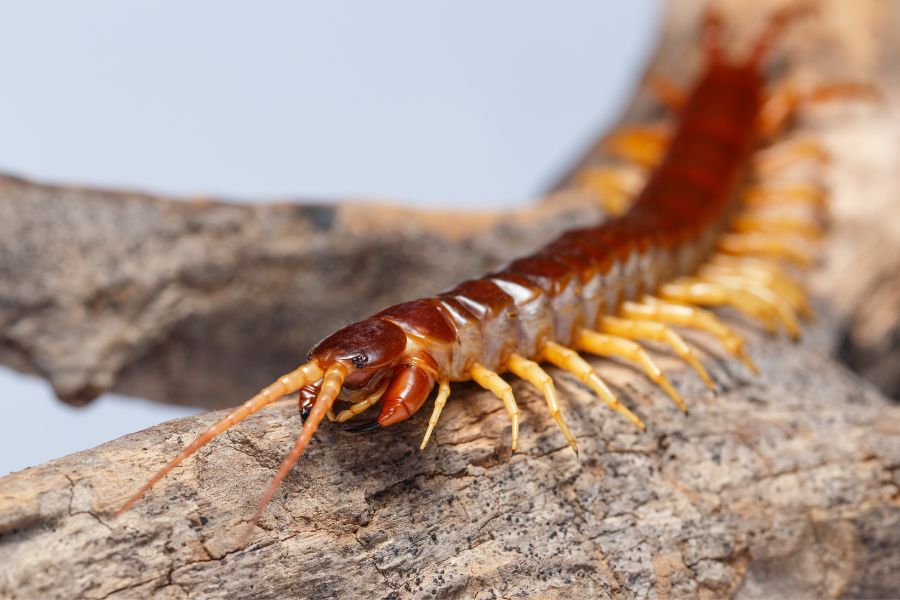
The Giant Centipedes, with subspecies known as Vietnamese Centipede, Chinese Red Headed Centipedes, Asian Forest Centipedes, are commonly found in the nooks and crannies of Thailand’s lush jungles.
They can reach up to 12 inches in length and live for around 10 years.
While their size alone is enough to send shivers down your spine, these venomous creatures can deliver a painful bite, though it’s not known to be fatal.
However, you should be careful where you tread and shake out your shoes, as you’ll want to avoid any unwanted encounters with these multi-legged nightmares.
- Where in Thailand can you find it: They tend to live in jungled areas in Thailand, and are known to hide under rocks, in tree logs, or under damp leaves or loose soil. They prefer humid and moist climates, so tend to stay in the jungle. However, it has been known to find hiding inside shoes.
- When are they most active? Centipedes are nocturnal hunters and so are most active at night. They tend to shy away from light and feed on ants, spiders, and crickets which also come out at night.
- What to do if you encounter one: If you spot one, stay away from it and don’t aggravate it. If you find one in your shoe, shake it out and use a broom or long pole to push it to a safe area.
- What happens if they bite you? The bite from a centipede is often compared to that of a bee sting. The painful feeling should subside within a few days, but if a Giant Centipede bites a child, then they need to seek medical attention immediately.
4. Feral Stray Dogs

Probably the most dangerous threat you may encounter in Thailand isn’t necessarily a wild animal at all.
It’s the feral dogs, also called stray dogs, that roam certain areas that pose the biggest threat. While some dogs are owned and used as protection, stray dogs are wild and can sometimes live in packs. It’s estimated there are around 800,000 stray dogs living in Thailand.
The wild packs of stray dogs can often carry diseases such as Rabies, not to mention their aggressive bites can wound unsuspecting travelers.
While most stray dogs are used to humans and tend to stay away from them, they can sometimes be spooked by scooters and passing cars. We encountered one particularly aggressive one on Baan Tai Beach in Koh Phangan once, who ran right up to us and barked at us just for walking.
They can be unpredictable, and while dogs are cute, it’s best not to approach a stray dog. Where possible, try to avoid any confrontations with these canines.
- Where in Thailand can you find it: stray dogs tend to live in rural areas such as in the outskirts of cities. We have encountered wild dogs on the islands, such as Koh Phangan, as well as in rural parts of Pai. Bangkok is estimated to have 300,000 stray dogs alone.
- When are they most active? stray dogs are active all through the day and all through the night, though arguably they are more aggressive at dawn and dusk.
- What to do if you encounter one: don’t look them in the eyes, remain calm and try not to be afraid (they can sense fear and confuse it with aggression). Back away slowly and don’t make any sudden movements or loud noises. Don’t run, as this can trigger their instinct to chase you. If one comes up to you, stay still and keep your head down.
- What happens if they bite you? If you are bitten by a stray dog, you will need to seek medical attention for your injuries and you may also need to receive rabies treatment and a tetanus shot.
5. Mosquitoes
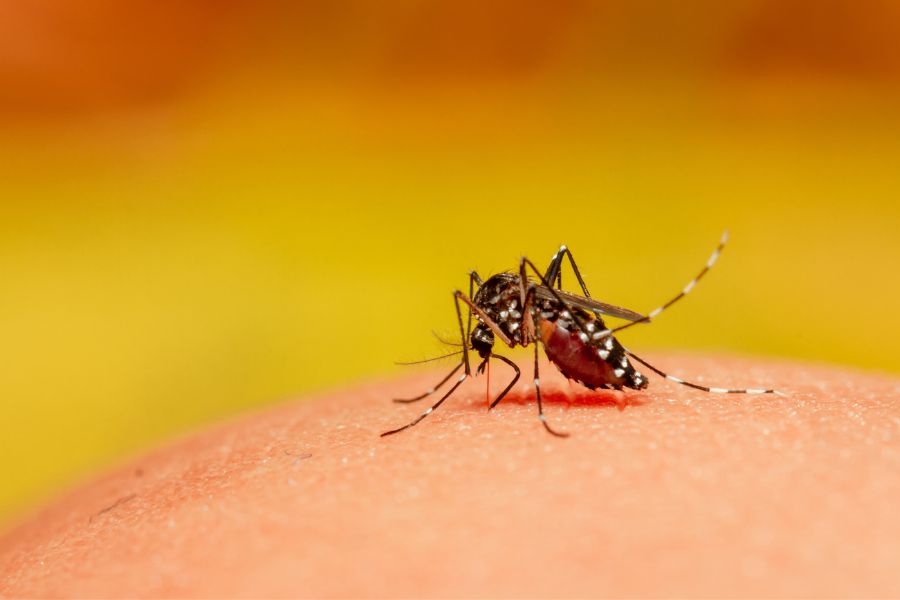
The Tiny Vampires of the Tropics may not seem like much of a threat, but it’s the mosquitoes in Thailand that can cause the biggest harm to humans since they carry some serious diseases, including dengue fever and malaria.
Protect yourself by using mosquito repellent, wearing appropriate clothing, and staying in accommodations with screens or air conditioning. Don’t let these tiny vampires ruin your adventure!
- Where in Thailand can you find it: Mosquitos are found all over Thailand and are pretty much unavoidable, sorry.
- When are they most active? Mosquitos love warm and humid climates, and are most active during the early morning period when the sun is coming up. When the sun is too hot, the heat can dehydrate them, so they tend to hide away during the day, and come out again at night.
- What to do if you encounter one: Where possible, try not to allow mosquitos to land on you, as their bites can be quick and stealthy.
- What happens if they bite you? Keep the area clean and try not to scratch, especially don’t break the surface of the skin as this can cause scarring. Use itch-relief creams if necessary.
6. Huntsman Spider
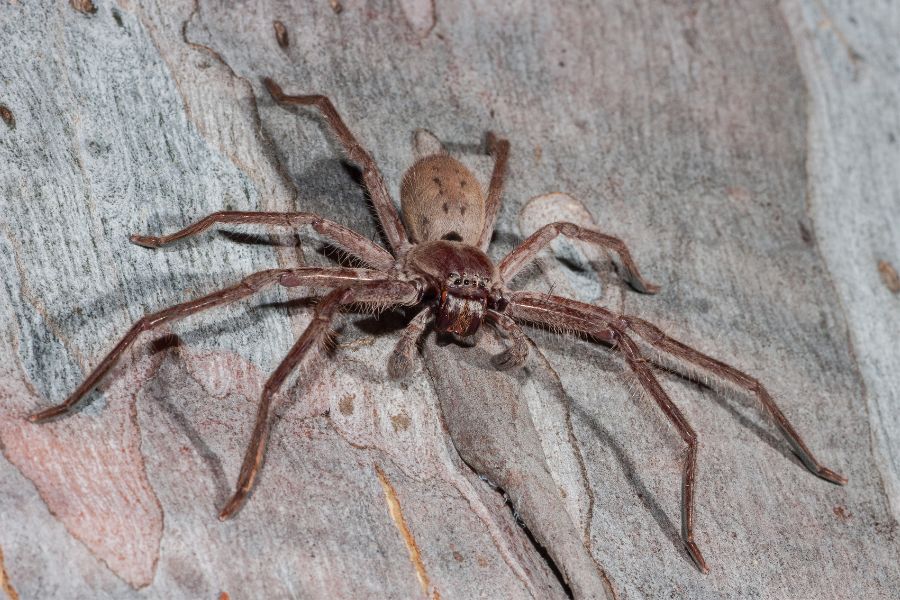
Here’s another one of the creepy crawlies you might come across in Thailand – the Huntsman Spider. Now, don’t let their name scare you too much because they’re not as dangerous as they look.
The bite of a Huntsman is venomous, but symptoms (compared to the other animals we’ve shown you on this list) are usually not serious. Those bitten by Huntsmans may feel uncomfortable, include moderate nausea or headaches, and cause localized inflammation and pain.
What makes the Huntsman so scary is its size and speed. They can grow to lengths of 30cm long, and can run 30-40 times their body length a second – that’s up to 5 meters per second.
- Where in Thailand can you find it: You can find the Huntsman Spider in various regions of Thailand, including both urban and rural areas. They love to hang out in warm, tropical climates, so keep an eye out for them when you’re exploring the nooks and crannies of this beautiful country.
- When are they most active? Well, they tend to come out at night, seeking prey under the cover of darkness. So, if you’re out and about after sunset, be prepared to encounter these little adventurers.
- What to do if you encounter one: First off, don’t panic! These spiders are generally harmless to humans and tend to avoid confrontation. If you encounter one, simply give it some space and let it go about its spider business.
- What happens if they bite you? Luckily, their bites are usually not a big deal. You might experience some minor pain, swelling, or redness at the site of the bite, but severe reactions are very rare. However, if you have any concerns or experience any unusual symptoms, it’s always a good idea to seek medical attention just to be safe.
7. Rockfish

These camouflaged creatures can be found along rocky coastlines throughout Thailand, wherever you’re swimming in the Indo-Pacific region. They’re masters of disguise, blending in with the surrounding coral and rocks, making them practically invisible to spot.
When it comes to their size, Rockfish can vary from 10 to 50 centimeters long. Their markings are truly a sight to behold! And here’s a fun fact – some species of Rockfish can even change their color!
- Where in Thailand can you find it: Anywhere in the Indo-Pacific Ocean.
- When are they most active? Well, you’ll typically spot them during your snorkeling adventures in Thailand’s crystal-clear waters. They tend to swim around corals and come out during sunrise and sunset, as well as be more active in the summer months.
- What to do if you encounter one: First things first, admire them from a respectful distance. These creatures are not to be disturbed or handled. Appreciate their beauty but remember to give them their space.
- What happens if they bite you? In the unlikely event of a Rockfish bite, it may cause pain or infection. However, rest assured that severe toxicity is rare. While Rockfish are not known for being aggressive towards humans, it’s essential to note that some species possess venomous spines. If you ever have any concerns or experience unusual symptoms after encountering a Rockfish, it’s always a good idea to seek medical attention. Better safe than sorry, right?
8. Malayan Krait Snake
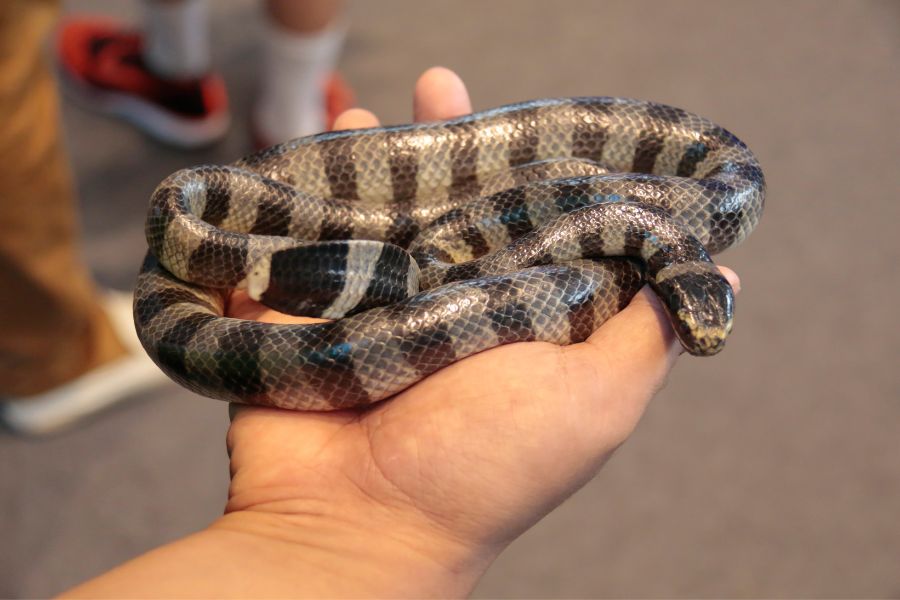
The Malayan Krait Snake, also known as the Blue Krait and are highly venomous, so it’s important to give them their space.
They are characterized by their black and white stripes and can grow to over 1 meter in length.
While they prefer to live in fields amongst crops, they occasionally make their way into habituated areas, so they are something to look out for.
Their bites are not fatal unless untreated, in which case the mortality rate is 60-70-% for humans.
- Where in Thailand can you find it: You can find the Malayan Krait all over Thailand and other parts of Southeast Asia. They like to hang out in various habitats, from flatlands to hilly areas. They’re not typically found within Bangkok itself.
- When are they most active? They tend to come out at night, hunting for their prey under the cover of darkness. If you’re out and about in snake territory after sunset, stay alert and keep your distance.
- What to do if you encounter one: If you encounter a Malayan Krait remember to stay calm and avoid any sudden movements. Do not try to handle or provoke it. Instead, slowly back away and give it plenty of space to retreat. It’s best to appreciate these creatures from a safe distance.
- What happens if they bite you? If by any unfortunate chance you get bitten by a Malayan Krait, seek medical attention immediately. Their venom can be highly toxic and potentially life-threatening. Time is of the essence, so don’t delay in getting medical help.
9. Macaque Monkeys
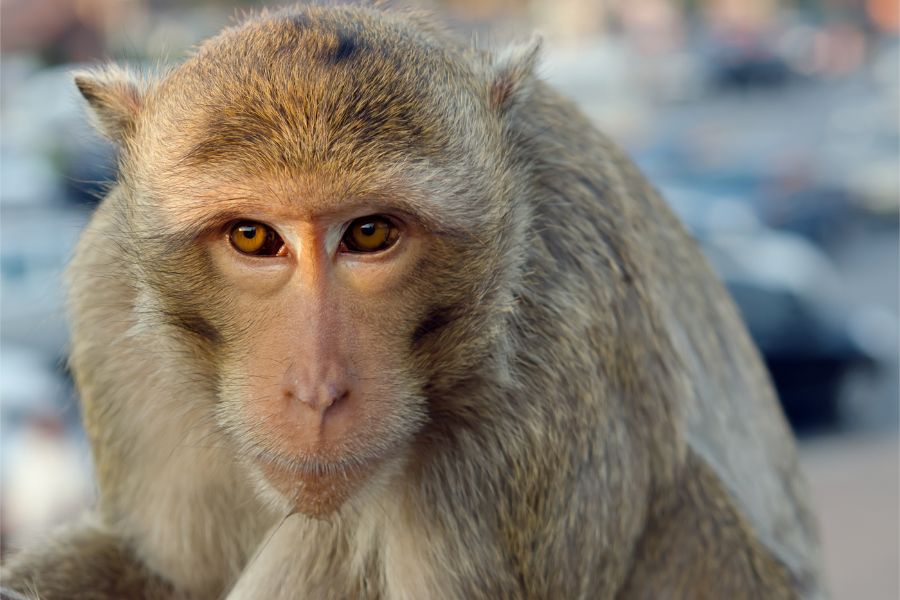
We’ve all seen them, the mischievous macaques roaming around the temples and on the sides of the roads in Thailand. While they may look adorable, these animals can be pretty dangerous when they feel threatened.
They may seem friendly, especially as they are used to humans and will not shy away from you if you have food on you, but they’re still wild animals.
What makes them dangerous is that they sometimes carry diseases such as Rabies. Mothers are protective of their babies, and while macaque attacks are rare, they do still happen.
- Where in Thailand can you find it: You’ll likely spot them in various jungle regions, but one famous place to encounter them is Lopburi, in central Thailand. They also live on Koh Phangan between Baan Tai and Haad Rin, as well as on the Southwest Side of Koh Lanta near Bamboo Beach. We met some particularly aggressive ones at the Tiger Cave Temple in Krabi.
- When are they most active? They are most active during the day as they hunt for food to eat.
- What to do if you encounter one: Keep your distance and do not approach, especially the mothers with babies. Keep all belongings inside your bags and wear your bags on the front. Don’t have any water bottles, snacks, sunglasses, or loose items on display, as they won’t hesitate to take them. Avoid direct eye contact and sudden movements to prevent any potential misunderstandings.
- What happens if they bite you? If you are bitten, seek medical attention immediately. You may need to undergo emergency treatment for rabies, though it’s usually just a precaution.
10. Stinging Caterpillar
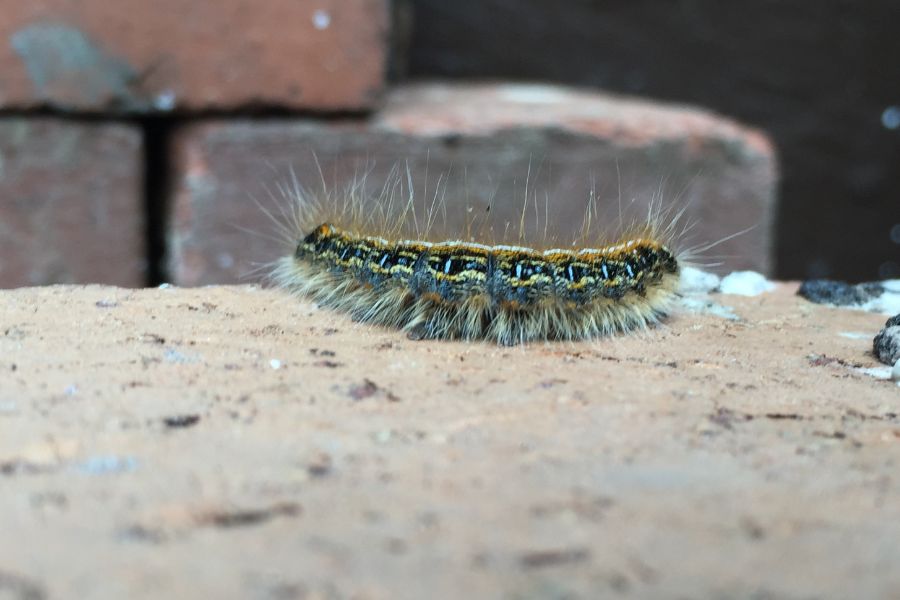
Caterpillars can sometimes look cute, but they are also the not-so-friendly side of nature in Thailand. Some species, specifically the Stinging Nettle Caterpillar, can pack quite a punch!
While their stings are not known to be fatal, they can be very painful and some people can experience allergic reactions. Not to mention their spines can stick to the skin and be troublesome to remove.
In fact, the way the Stinging Caterpillar catches its pray is by releasing its spines, or nettles, which gets dislodged in birds throats and eventually kill them.
- Where in Thailand can you find it: You can find these stinging caterpillars throughout Thailand, especially in forested areas and gardens. They like to hide among leaves and branches, so keep an eye out when you’re exploring nature.
- When are they most active? They’re most active during warmer months, typically from spring to autumn. That’s when they come out to chow down on leaves and prepare for their transformation into beautiful butterflies or moths.
- What to do if you encounter one: steer clear! Avoid touching them or even getting too close. These caterpillars have tiny hairs that can cause severe reactions if they come into contact with your skin.
- What happens if they bite you? If you get bitten by a dangerous caterpillar, you might experience intense pain, burning sensations, itching, and even severe dermatitis. It’s essential to seek medical attention immediately to treat any symptoms or allergic reactions.
11. Leeches
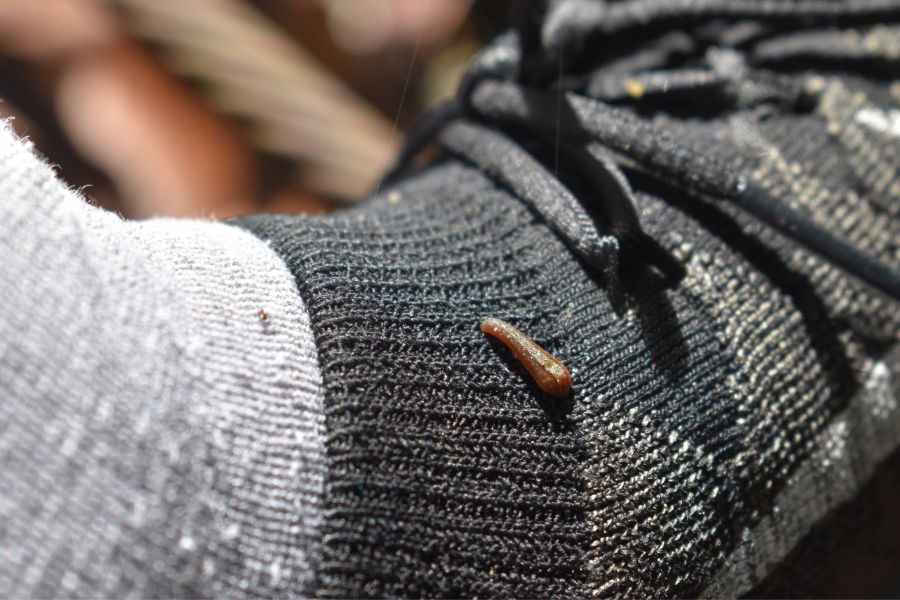
Now, you might think they’re dangerous, but the truth is, their bites are actually not harmful. In fact, some people even intentionally use leeches for medical treatment.
What does make them dangerous though is not knowing how to act if you encounter one. Those who freak out and pull leeches off them without knowing the proper way to remove them can either cause haemorrhaging in the wound area, or risk infection as particles of leech get into the blood stream.
Most of the leeches in Thailand are found in freshwater supplies such as swamps and rivers. The most common species of leech in Thailand is the Hirudinaria leech.
While leeches may give you the heebie-jeebies, remember that they’re not as dangerous as others in Thailand, and usually you won’t ever encounter them unless you visit the jungles.
- Where in Thailand can you find it: You can find leeches in various jungle places in Thailand, particularly in national parks like Khao Sok National Park. They love moist environments like rainforests, streams, and even floodwaters during heavy rains.
- When are they most active? leeches are most active during wet seasons and when flooding occurs. So, if you’re venturing into the jungle or exploring streams, be cautious.
- What to do if you encounter one: if a leech bites you, you should either wait until it’s done feeding and let it drop off, or try to remove it by gently sliding your fingernail or a credit card under the leech and peel it off. The health advice by Healthline is to void using bug spray as this causes the leech to vomit and can cause infections.
- What happens if they bite you? leech bites are generally harmless. However, if you have concerns or notice any unusual reactions like severe bleeding or infection, it’s best to seek medical attention just to be safe.
12. Black Widow Spiders and Redback Spiders
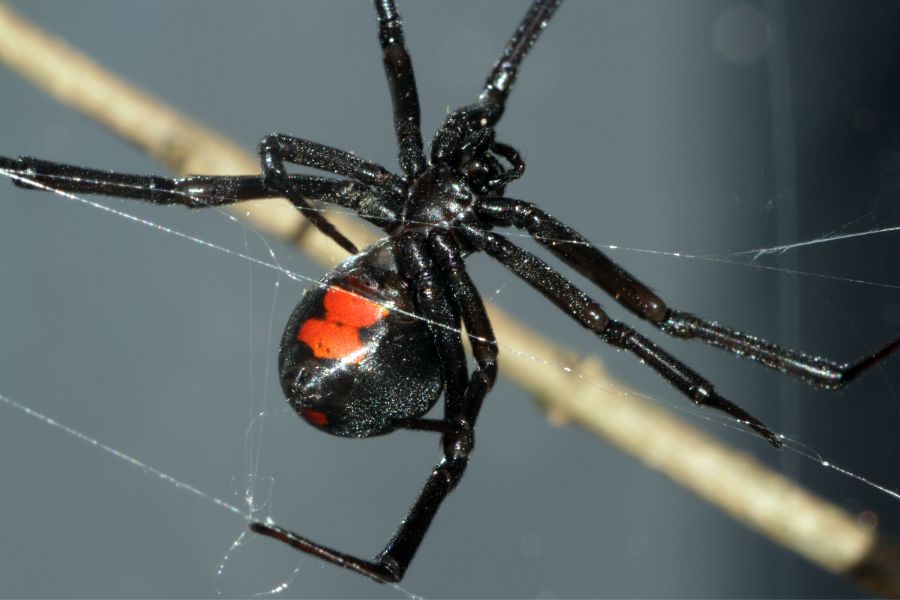
Another arachnid you need to be careful of are the Black Widow Spider, and less commonly the Redback Spider. Now, you might think spiders are just creepy, but these little critters can be dangerous.
The Redback Spider belong to the same family as the Black Widow, and are more commonly associated with Australia, though sightings of Redbacks have been reported in Thailand over the years.
Fortunately, sightings of them are rare, and they typically hide under logs or fallen pieces of wood.
However the Black Widow has made several appearances in Thailand. They are infamous for their nasty bites, especially from the females, which can cause severe symptoms though they are rarely fatal.
- Where in Thailand can you find it: Well, they can be found in various regions and have migrated almost everywhere. Keep an eye out, especially in places like Udon Thani.
- When are they most active? Black Widows and Redbacks are predominantly active during the night as they are nocturnal animals. You might encounter them more frequently in spring and summer.
- What to do if you encounter one: the best course of action is to keep your distance and avoid provoking or touching it. It’s important to respect their space and let them go about their spider business.
- What happens if they bite you? A Black Widow or Redback Spider bite can be painful and potentially dangerous. If you get bitten, it’s crucial to seek immediate medical attention. Symptoms can range from localized pain to nausea, vomiting, and even muscle weakness. Bites from these spiders are rarely fatal, but can be very painful.
13. Bull Sharks and Tiger Sharks

There are many species of shark in Thailand, such as Black Tip Reef Sharks, Whale Sharks, and Nurse Sharks, but most of them do not pose a threat to humans.
Ones that have been known to pose a threat to humans are the Bull Shark and Tiger Shark, which can be found in the deep waters of Thailand.
Although sightings are rare because they prefer to live in deep water, their presence can be chilling.
The Bull Shark used to be more present in Thailand, but sources are finding their presence is disappearing, probably due to the presence of shark fishing for their fins.
The Tiger Shark is the species that is most often blamed for attacking humans, though again, sightings of them in Thailand’s waters are rare.
- Where in Thailand can you find it: These sharks prefer cooler and deeper waters, so they’re not commonly spotted in popular diving areas like Koh Tao, and you usually need to travel further out to see to find them. They used to be in large quantities in Chumphon Pinnacle or Sail Rock, but now there are only occasional sightings.
- When are they most active? these sharks don’t have a specific season of activity. They can be encountered throughout the year, but remember, sightings are still infrequent.
- What to do if you encounter one: Stay calm and back away slowly. Maintain a safe distance and avoid any sudden movements. The advice from the experts is to not splash or turn your back on it, it’s best to swim backwards so you can watch it, but don’t make direct eye contact.
- What happens if they bite you? shark attacks are extremely rare. But if, by some slim chance, you do get bitten, seek immediate medical attention. The bites from bull sharks and tiger sharks can be serious.
14. Yellow Sac Spider
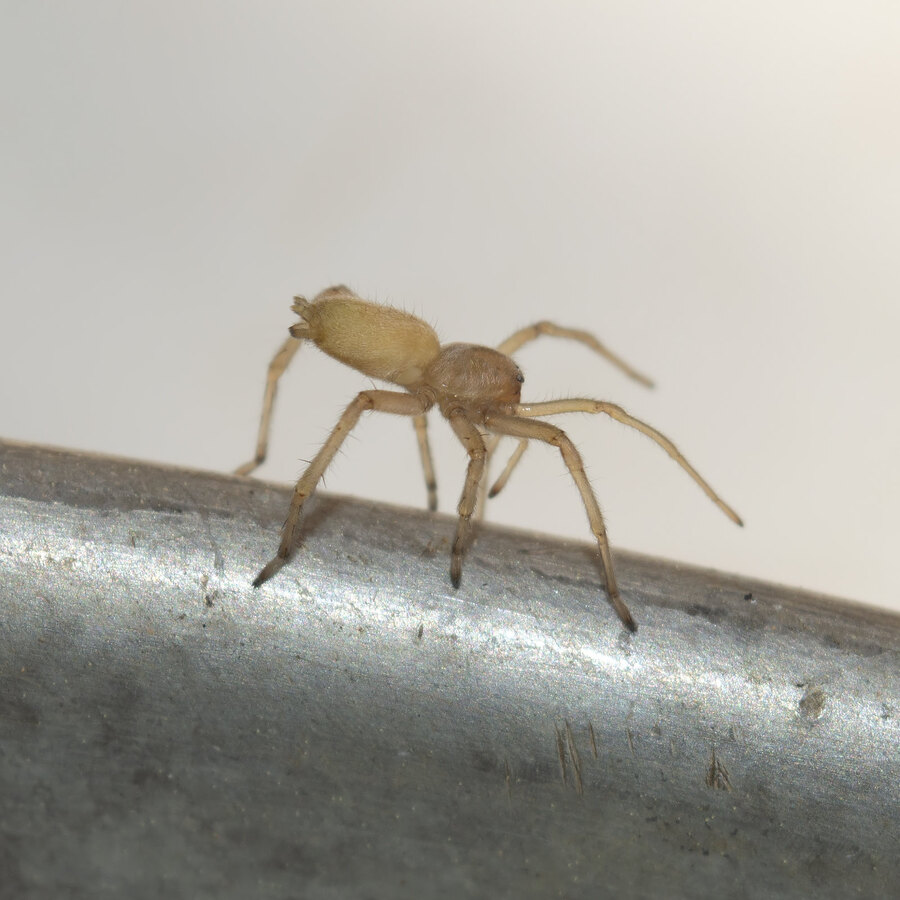
The yellowsac spider is a small spider that belongs to the Cheiracanthium genus family, and are known for their tiny size, ranging between 5 and 10 mm long.
They are usually a pale color, and have a yellow-colored abdomen, hence the name ‘Yellowsac’.
These eight-legged creatures can sometimes find their way into homes, and can be seen on walls and ceilings, but will fall on the floor if they are disturbed.
They also have a painful bite, though they are not known to be fatal. However, these are not a spider in Thailand you want to disturb.
- Where in Thailand can you find it: You can find yellowsac spiders in various regions of Thailand.
- When are they most active? sac spiders are nocturnal creatures and actively hunt their prey at night (usually small insects).
- What to do if you encounter one: These spiders are generally non-aggressive. Simply give them their space and avoid provoking them. After all, they’re just doing their spider thing.
- What happens if they bite you? their bites can be quite unpleasant, causing sharp pain that can last up to ten days. If you do get bitten, clean the affected area, apply a cold compress, and consider seeking medical attention if symptoms worsen or persist.
15. Tropical Fire Ants
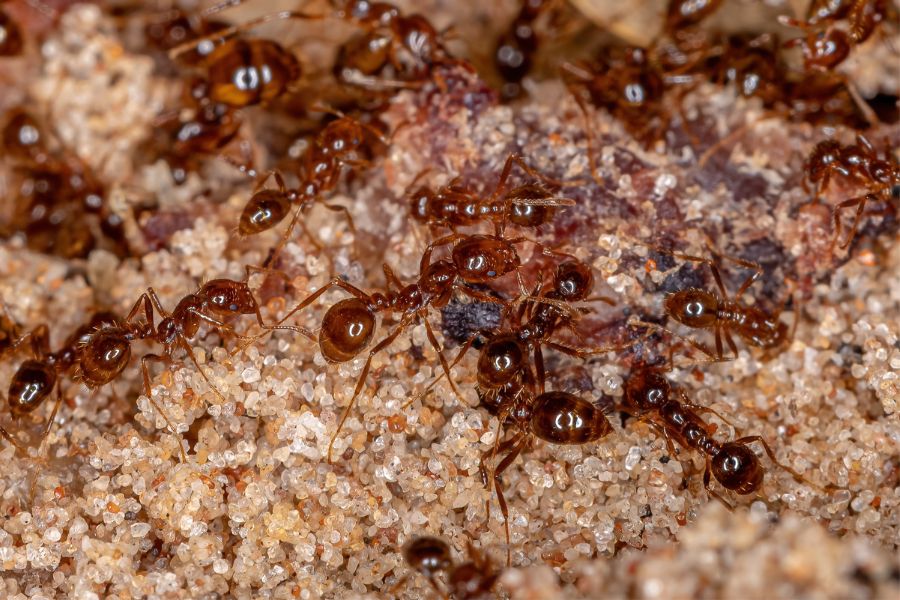
You can find tropical fire ants, known as Solenopsis geminata, across Thailand. While they are not fatal, their bites can cause allergic reactions that can be life-threatening.
There are many species of ants in Thailand, which can make spotting the Tropical Fire Ant difficult. They are often confused with Red Ants, which are common in Thailand and have a simialar red-orange coloration.
Tropical fire ants are usually orange to brown in color and can measure between 3mm-5mm long, and are characterized by their square heads.
They live in large colonies and are known to be aggressive if disturbed.
- Where in Thailand can you find it: They love the warm tropical areas, so keep an eye out for them in those regions. They are usually found in grassy areas such as fields, but can be found in houses.
- When are they most active? they tend to be more active during the spring and fall months. So, be extra cautious during that time. They tend not to be a problem during the winter as they don’t like cold weather.
- What to do if you encounter one: stay calm and avoid provoking them and slowly back away from their path. Give them their space and let them go about their ant business without any interference.
- What happens if they bite you? Their bites can be painful, causing redness, swelling, and itching. If you get bitten, clean the area with soap and water, apply a cold compress, and consider using antihistamine creams or taking oral antihistamines to ease the discomfort. Seek medical attention if you experience severe reactions or allergies.
16. Red Lionfish
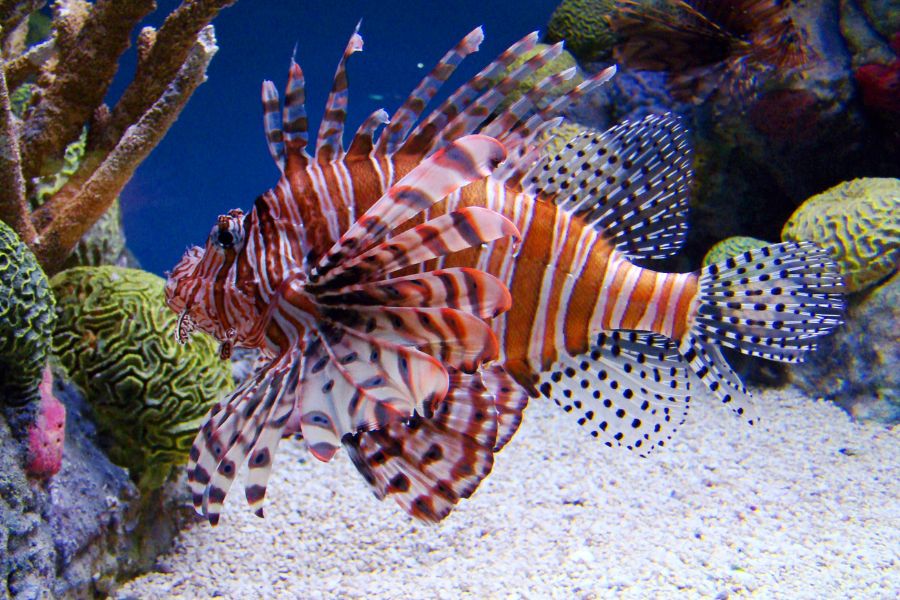
The Red lionfish, scientifically known as Pterois volitans, is one of the most dangerous animals in the ocean, having few predators other than the shark, groupers and eels.
They are slow and stealthy hunters, and are easily identifiable by their red, brown and white and striped bodies, with azebra-like appearance. There are 16 species of lionfish, but it’s estimated that 97% are Red Lionfish.
Fun fact: The stomach of the Red Lionfish can stretch to 30 times the size of its original volume.
Whether you’re scuba diving or snorkeling, keep an eye out for these beautiful fish with their vibrant colors and distinctive stripes.
- Where in Thailand can you find it: They are often found in ledges and crevices among the rocks and corals. They have been sighted in popular dive sites off Koh Tao, such as Chumphon Pinnacle, the shipwreck of HTMS Sattakut, and Junkyard Reef.
- When are they most active? Red Lionfish are generally active during dawn and dusk when the sunlight isn’t too strong.
- What to do if you encounter one: Admire them from a safe distance, but keep your hands to yourself and avoid touching or disturbing them. Remember, they have venomous spines and don’t appreciate unwanted attention.
- What happens if they bite you? Their sting can be painful, causing extreme discomfort. You might experience headaches, vomiting, or difficulty breathing. If you get stung, seek medical assistance immediately to treat the symptoms and ensure proper care.
17. Scorpions
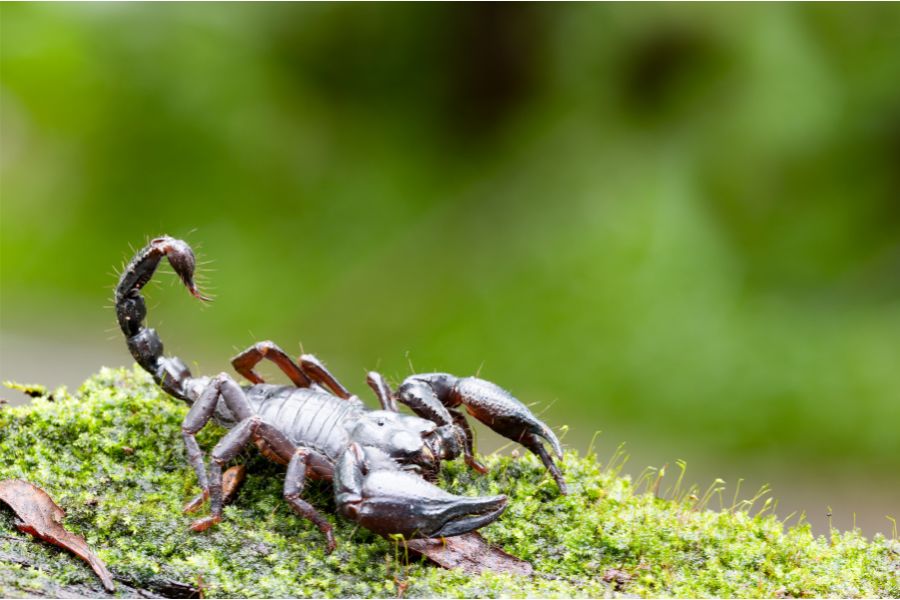
Finally, let’s talk about scorpions in Thailand. These little critters might give you a fright, but don’t worry, we’ll fill you in on all the important details.
There are 18 known species of Scorpion in Thailand, and are known for their large pair of powerful pincers at the front end, and poison-whipped tail at the back. Some scorpions average between 10cm-17 cm long, and females tend to be larger than males.
Scorpions generally aren’t too dangerous, though. Their venom is mild, similar to a bee or wasp sting. So, while they might give you a painful pinch, they aren’t considered a serious health risk.
That being said, some people are allergic to scorpion stings and so a sting to some people may be life threatening.
- Where in Thailand can you find it: You can find scorpions all over Thailand, especially the black scorpion species, which is the most common.
- When are they most active? Scorpions in Thailand are active year-round, but they tend to be more active during the warmer months. So, keep an eye out for them when temperatures rise.
- What to do if you encounter one: Give them their space and avoid provoking them. Remember, they’re just doing their scorpion thing. If you see one indoors, gently guide it outside using a broom or a container.
- What happens if they bite you? Their sting can be painful, similar to a bee sting. But fear not, it’s usually harmless. Clean the area with soap and water, and clean with iodine. Seek medical attention if you have an allergic reaction or experience severe symptoms.
Thailand’s Dangerous Animals FAQs
Here’s what people usually ask us about dangerous animals in Thailand…
What is the number 1 deadliest animal in Thailand?
Mosquitos are the deadliest animal in Thailand as they pose the biggest threat to humans. Mosquitos carry deadly diseases, such as dengue fever and the Zika virus. However, you can protect yourself from these creatures by wearing Deet bug spray.
What dangerous animals are in Phuket?
The most dangerous animal you would encounter in Phuket is the Spitting Cobra. Phuket is known to have several species of snake live on the island, but they usually stay in urban jungle areas and away from human habitation.
What dangerous animals are in Koh Samui?
In Koh Samui, you are most likely to encounter snakes, scorpions and centipedes. On its neighboring island of Koh Phangan, there is a feral dog population that travelers should watch out for.
Final Thoughts
Remember, this list is just a glimpse into the diverse and sometimes perilous world of Thailand’s wildlife, but the vast majority of these animals live in jungles or in reefs far away from the coast.
While the chances of you stumbling across one of these deadly animals in Thailand are rare, and we know the contents of this guide may be unsettling, it’s essential to know what to look out for so you can avoid them at all costs.
If you do encounter a dangerous animal, respect these animals space and their habitats, and don’t approach them – appreciate them from a safe distance and refrain from any actions that may provoke them.

I live in Thailand now. I am from Canada. In my home I have seen huntsman spiders, they are very big, saw big centipedes in our home, saw a black snake and found snake skins in our home too. I married a Thai woman here.
Thailand also has these dangerous animals. Paper wasps, Murder Hornets ,Crocodiles and Wild Asian Elephant.
Hi Ken, thank you for your suggestions!
I would argue that mosquitoes in Thailand are not dangerous at all. My evidence is that I (and millions of people in Thailand) have been bitten numerous times a day throughout the rainy season for many years and have never contracted any disease as a result. Yes, I have heard of cases of denge, but not nearly as often as you would expect, given the number of mosquito bites administered every day. In 12 years no one I know has got denge.
Having also been stung by a scorpian, wasps and been confronted by vicious “soi dogs”, I can tell you I’d rather be bitten by 1,000 mosquitoes than deal with any of the forementioned!
Added to your list should be the Malayan Pit Viper. These snakes are very common and lay very still, coiled up and often covered with leaves. Unlike other snakes, like cobras and such, they don’t move when you come close so it’s easy to step on them while out hiking.